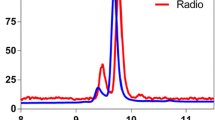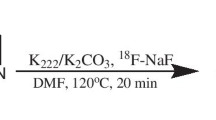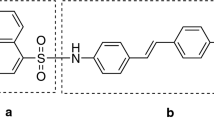Abstract
Beta-secretase (BACE1), a transmembrane aspartyl protease, can cleave membrane-bound β-amyloid precursor proteins (APPs) to initiate the accumulation of amyloid-β (Aβ). The inhibition of BACE-1 to limit the accumulation of neurotoxic Aβ peptides could offer a potential treatment for Alzheimer’s Disease (AD). However, little is known about the distribution and density of BACE1 in the central nervous system. As a step toward filling this gap in knowledge, we have evaluated a potential radiotracer for the imaging of BACE1 using positron emission tomography (PET). A BACE1 inhibitor, 5, is reported with blood-brain barrier (BBB) permeability and high binding affinity. To characterize the pharmacokinetics and distribution of 5 in the brain, we radiolabeled 5 with carbon-11. Using PET, we found that [11C]5 shows moderate uptake in the brain when administered intravenously to rodents and further work will be performed in animal models to test its application as a PET imaging probe for the central nervous system. Our study demonstrates the effectiveness of PET at providing brain pharmacokinetic data for BACE1 inhibitors, crucial for the development of treatments for AD where CNS penetration is critical.




Similar content being viewed by others
References
Eketjall S et al. (2016) AZD3293: a novel, orally active BACE1 inhibitor with high potency and permeability and markedly slow off-rate kinetics. J Alzheimers Dis 50(4):1109–1123
Forman M, Palcza J, Tseng J, Leempoels J, Ramael S, Han D, Jhee S, Tanen M, Ereshefsky L, Laterza O, Dockendorf M, Krishna G, Ma L, Wagner J, and Troyer M (2012) The novel BACE inhibitor MK-8931 dramatically lowers cerebrospinal fluid Aβ peptides in health subjects following single- and multiple-dose administration. Alzheimers Dement 8:704
Friedman LG, Qureshi YH, Yu WH (2015) Promoting autophagic clearance: viable therapeutic targets in Alzheimer’s disease. Neurotherapeutics 12(1):94–108
Ginman T et al. (2013) Core refinement toward permeable beta-secretase (BACE-1) inhibitors with low hERG activity. J Med Chem 56(11):4181–4205
Hardy JA, Higgins GA (1992) Alzheimer’s disease: the amyloid cascade hypothesis. Science 256(5054):184–185
Heerboth S et al. (2014) Use of epigenetic drugs in disease: an overview. Genet Epigenet 6:9–19
Jiang Y et al. (2016) Partial BACE1 reduction in a Down syndrome mouse model blocks Alzheimer-related endosomal anomalies and cholinergic neurodegeneration: role of APP-CTF. Neurobiol Aging 39:90–98
Jonsson T et al. (2012) A mutation in APP protects against Alzheimer’s disease and age-related cognitive decline. Nature 488(7409):96–99
Kawai T et al. (2013) Synthesis and evaluation of 11C-labeled naphthalene derivative as a novel non-peptidergic probe for the beta-secretase (BACE1) imaging in Alzheimer’s disease brain. Nucl Med Biol 40(5):705–709
Kimura R, Devi L, Ohno M (2010) Partial reduction of BACE1 improves synaptic plasticity, recent and remote memories in Alzheimer’s disease transgenic mice. J Neurochem 113(1):248–261
Lai R, Albala B, Kaplow JM, Aluri J, Yen M, Satlin A (2012) First-in-human study of E2609, a novel BACE1 inhibitor, demonstrates prolonged reductions in plasma beta-amyloid levels after single dosing Alzheimers Dement 8:96
McConlogue L et al. (2007) Partial reduction of BACE1 has dramatic effects on Alzheimer plaque and synaptic pathology in APP Transgenic Mice. J Biol Chem 282(36):26326–26334
Nordeman P et al. (2014) (11)C-Labeling of a potent hydroxyethylamine BACE-1 inhibitor and evaluation in vitro and in vivo. Nucl Med Biol 41(6):536–543
Oehlrich D, Prokopcova H, Gijsen HJ (2014) The evolution of amidine-based brain penetrant BACE1 inhibitors. Bioorg Med Chem Lett 24(9):2033–2045
Probst G, Xu YZ (2012) Small-molecule BACE1 inhibitors: a patent literature review (2006 - 2011). Expert Opin Ther Pat 22(5):511–540
Sathya M et al. (2012) BACE1 in Alzheimer’s disease. Clin Chim Acta 414:171–178
Sun X et al. (2006) Increased BACE1 maturation contributes to the pathogenesis of Alzheimer’s disease in Down syndrome. FASEB J 20(9):1361–1368
Vassar R (2014) BACE1 inhibitor drugs in clinical trials for Alzheimer’s disease. Alzheimers Res Ther 6(9):89
Wang C et al. (2014) In vivo imaging of histone deacetylases (HDACs) in the central nervous system and major peripheral organs. J Med Chem 57(19):7999–8009
Yang LB et al. (2003) Elevated beta-secretase expression and enzymatic activity detected in sporadic Alzheimer disease. Nat Med 9(1):3–4
Zhang L et al. (2013) Design and selection parameters to accelerate the discovery of novel central nervous system positron emission tomography (PET) ligands and their application in the development of a novel phosphodiesterase 2A PET ligand. J Med Chem 56(11):4568–4579
Acknowledgements
We are grateful to the Martinos Center radiopharmacy staff (Judit Sore, Kari Phan, Garima Gautam, and Samantha To) for help with radiotracer production. We are grateful to Brendan Taillon for assisting with rodent PET-CT studies. This research was supported by the Harvard/MGH Nuclear Medicine Training Program from the Department of Energy under Grant DE-SC0008430 (C.W.). This research was carried out at the Athinoula A. Martinos Center for Biomedical Imaging at the Massachusetts General Hospital, using resources provided by the Center for Functional Neuroimaging Technologies, P41EB015896, a P41 Regional Resource supported by the National Institute of Biomedical Imaging and Bioengineering (NIBIB), and the National Institutes of Health. This work also involved the use of instrumentation supported by the NIH Shared Instrumentation Grant Program and/or High-End Instrumentation Grant Program; specifically, Grant Number: S10RR015728.
Author information
Authors and Affiliations
Corresponding author
Ethics declarations
Conflict of interest
The authors declare that they have no conflict of interest.
Additional information
Publisher’s note Springer Nature remains neutral with regard to jurisdictional claims in published maps and institutional affiliations.
Rights and permissions
About this article
Cite this article
Zhu, Y., Fiedler, S.A., Hibert, M.L. et al. Synthesis of a carbon-11 radiolabeled BACE1 inhibitor. Med Chem Res 29, 262–267 (2020). https://doi.org/10.1007/s00044-019-02480-9
Received:
Accepted:
Published:
Issue Date:
DOI: https://doi.org/10.1007/s00044-019-02480-9




